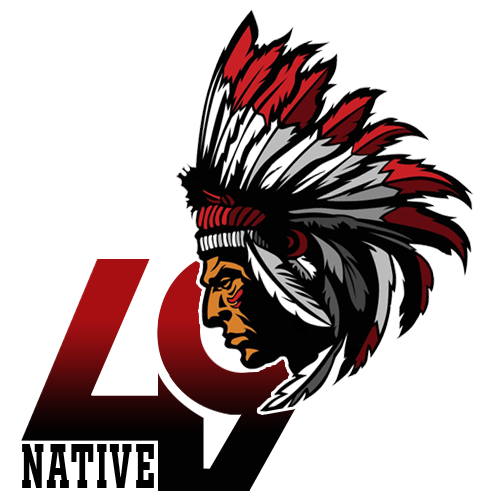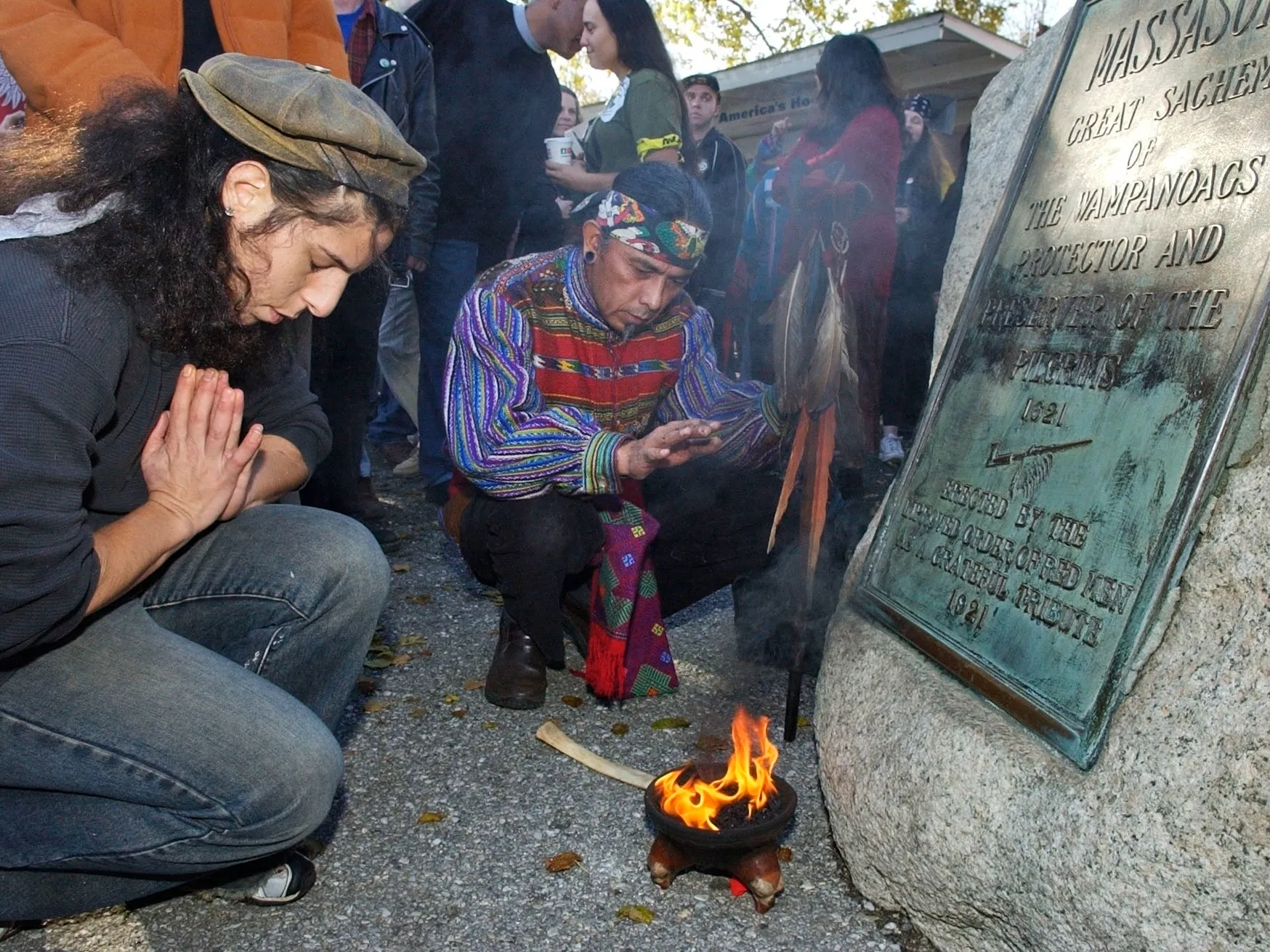The Native American Day of Mourning, an annual observance with profound historical and cultural significance, beckons us to delve into the heart of Native American experiences. This solemn and reflective day stands as a testament to a rich heritage, marked by both strength and struggle.
In this exploration, 49native will unravel the origins, purpose, and enduring importance of Native American Day of Mourning, shedding light on a chapter of history that continues to resonate in the present.
Why did the United American Indians have a day of mourning?
Frank James chose his name in honor of Wamsutta, also known as Alexander Pokanoket, the eldest son of Massasoit Ousamequin from the Pokanoket Tribe and the Wampanoag nation, as well as the brother of Metacomet.
Wamsutta played a significant role by selling Wampanoag lands to colonists outside the Plymouth Colony, amassing power but also arousing suspicion among the Plymouth colonists. His brief imprisonment and subsequent death raised suspicions among the tribe, potentially contributing to King Philip’s War in 1675.

Wamsutta’s memory endures in various commemorations around New Bedford, Massachusetts, and the naming of a US Navy steamer during the American Civil War (1863-1865). Frank James, who passed away in 2001, left behind a lasting legacy of Native American activism, championing awareness against racism and the enduring impacts of colonialism.
Today, the National Day of Mourning protest on Thanksgiving Day, now led by James’s son, Moonanum James, takes place on Cole’s Hill, not as a celebration of the Mayflower’s arrival, but as a solemn commemoration.
This protest, which began in 1970, aims to remember the genocide, land theft, and oppression of Native Americans. In 1997, a confrontation between protesters and police led to violence, resulting in several arrests. As part of a settlement with the town of Plymouth, a plaque was placed on Cole’s Hill, recognizing the importance of this protest and its message.
The plaque’s inscription reminds us that Thanksgiving Day carries the weight of Native American history – the genocide, land theft, and cultural oppression. National Day of Mourning participants honor Native ancestors and their ongoing struggles against racism and oppression. This day serves as a somber reminder and a call for change.
What Is The Date Of Native American Day Of Mourning?
The National Day of Mourning is a significant annual event observed on the fourth Thursday in November, alongside Thanksgiving, to shed light on the history, culture, and struggles of Native Americans in the United States.
This demonstration, initiated in 1970, is a tribute to the Wampanoag people and other Eastern United States tribes. Its primary goals are to dispel myths associated with the Thanksgiving narrative and create awareness about the historical and ongoing challenges faced by Native American communities.
The Origin of National Day of Mourning
The roots of the National Day of Mourning can be traced back to a pivotal moment in 1970 when Frank “Wamsutta” James was invited to speak at a Massachusetts Thanksgiving Day event commemorating the 350th anniversary of the Mayflower’s landing.
However, his invitation was unexpectedly revoked, prompting him to deliver his speech on Cole’s Hill in Plymouth, Massachusetts, near a statue of Ousamequin. During his speech, James presented a Native American perspective on the Thanksgiving celebrations, which set the stage for the annual observance know today.
The Role of United American Indians of New England (UAINE)
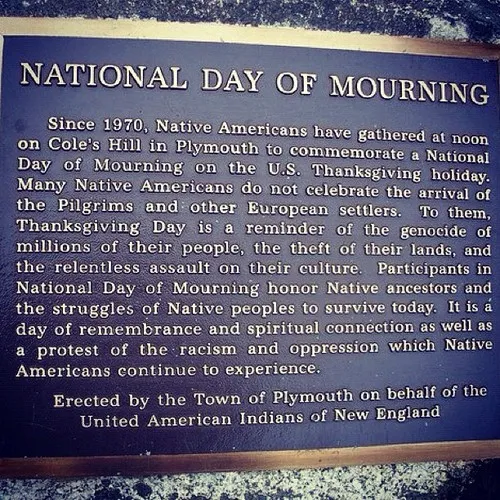
Since its inception, the National Day of Mourning has been meticulously organized by the United American Indians of New England (UAINE). This group plays a pivotal role in coordinating the event and ensuring its message is heard loud and clear. The UAINE seeks to dismantle misconceptions surrounding Native American history and advocate for the rights and concerns of Native American communities.
Converging with Unthanksgiving Day
The National Day of Mourning coincides not only with Thanksgiving Day but also with another significant event known as Unthanksgiving Day. Unthanksgiving Day is an annual ceremony held on Alcatraz Island in California, symbolizing a broader movement to recognize the suffering of Native American communities in the wake of colonization and the historical events associated with Thanksgiving.
Commemorating Native American Heritage
In essence, the National Day of Mourning serves as a platform for commemorating Native American heritage and history. It reminds us that while Thanksgiving is often viewed as a time of celebration, it is essential to acknowledge the painful aspects of history and the ongoing struggles faced by Native American tribes.
This event encourages open dialogue, education, and reflection, ultimately fostering a deeper understanding of the complex tapestry that is Native American history.
The National Day of Mourning stands as a poignant reminder of the need to appreciate and respect Native American heritage and history.
By dispelling myths and raising awareness about the challenges faced by Native American communities, this annual event serves as a testament to the resilience and cultural richness of the Wampanoag people and other Eastern United States tribes. It is a crucial step towards fostering mutual understanding and a shared commitment to justice and equality
How is the day of mourning celebrated?
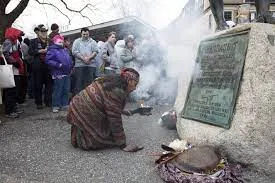
The National Day of Mourning has been an annual tradition since 1970, carrying profound spiritual and political significance.
It is a day of solemn remembrance, a day when Native Americans come together to fast, reflecting on the profound loss of their ancestors, the grievous genocide of their people, and the relentless theft of their lands. The National Day of Mourning (NDOM) is a powerful testament to the resilience and determination of Native American communities.
The Roots of National Day of Mourning
NDOM was born out of a necessity to remember and acknowledge the painful history of Native Americans. It began as a response to the conventional Thanksgiving narrative and sought to provide an alternative perspective, one that recognized the suffering and loss experienced by indigenous peoples.
This annual event is a time to pause and reflect on the impact of colonization and the enduring struggles faced by Native communities.
The Act of Fasting
A central element of NDOM is fasting. Many participants choose to fast from sundown the day before the event until the afternoon of NDOM. This act of fasting is not only symbolic but deeply spiritual.
It represents a connection with the past, an understanding of the sacrifices made by their ancestors, and a tribute to their resilience. The fast is broken in a social gathering after NDOM, creating a sense of unity and shared experience.
Mourning Ancestors and the Stolen Lands
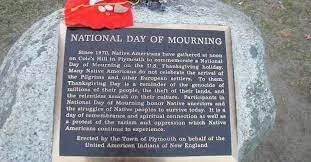
NDOM serves as a day to mourn not only for the ancestors but also for the lands that were stolen from Native communities. It provides a platform to express the collective grief over the displacement, suffering, and injustice that has persisted throughout history. While the day is marked by sadness, it also embodies the strength and determination to seek justice and equity.
Solidarity and Action
NDOM is not merely a day of mourning; it is a day of action and solidarity. Native Americans and their allies come together to advocate for their rights, express their grievances, and emphasize the need for change. It is a platform for raising awareness about the challenges faced by indigenous communities and mobilizing efforts to address them.
The Ongoing Struggles
NDOM is a reminder that the struggles of Native Americans continue to this day. It is a call to recognize that the injustices of the past have left a lasting impact on Native communities. The theft of lands, forced displacement, and cultural oppression are not historical relics but persist as present-day issues that demand attention and action.
The Resilience of Native Communities
The National Day of Mourning is a poignant and significant event in the calendar of Native American communities. It stands as a testament to the resilience and strength of indigenous peoples who, despite the deep wounds of history, continue to advocate for justice, equality, and the preservation of their culture.
It is a day for remembrance, reflection, and collective action, and it plays a crucial role in ensuring that the voices of Native Americans are heard, their stories acknowledged, and their struggles addressed.
What really happened at the first Thanksgiving feast in 1621?
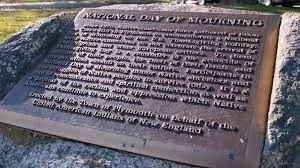
Thanksgiving, a time for family gatherings and abundant feasting, has been a cherished American tradition for centuries. As prepare to cook for our own crowds, it’s fascinating to look back at the origins of this holiday. More than just a celebration of gratitude, the first Thanksgiving provides a window into the past.
The First Thanksgiving: A Gathering of Many
At the inaugural Thanksgiving feast, held in the early 17th century, the guest list was quite impressive. Contrary to what might imagine, it wasn’t just a small gathering. In fact, more than 100 people attended that historic event. These early settlers and Native Americans came together to share a meal and, in many ways, lay the foundation for a tradition that continues to this day.
A Feast of Contrasts
The first Thanksgiving gathering was a unique blend of cultures. Approximately 90 Native men and 50 Englishmen came together to celebrate. It’s important to note that these were two very distinct groups with their own traditions and customs.
While the Native people dined sitting on the ground, mirroring their familiar practices, the English settlers ate at the table, in accordance with their customs. This duality of tradition added depth and diversity to the feast.
Beyond the Table: Activities and Merriment

Thanksgiving was not merely about eating. The attendees engaged in various activities to make the most of the celebration. They likely played marksmanship games, showcasing their skills, and ran footraces to infuse the gathering with a spirit of competition and camaraderie. These activities offered a balance to the indulgent feasting.
A Three-Day Celebration
One surprising aspect of the first Thanksgiving was its duration. The festivities extended for three days. The reason behind this extended celebration was practical. The Wampanoag, the Native American group in attendance, traveled a significant distance to join the feast. It took them two days to reach the location. The extra day allowed for a more leisurely and enjoyable celebration.
A Tradition Rooted in Time
The tradition of hosting overnight holiday guests during Thanksgiving can be traced back to this historical event. While the circumstances and settings have evolved over the centuries, the essence of togetherness and gratitude endures. As gather around our tables today, pay homage to those who came before, bridging cultures and traditions to create a holiday that truly unites us all.
Thanksgiving’s Timeless Legacy
Thanksgiving, as celebrate it today, is an embodiment of the rich history and multicultural tapestry that makes up the United States. The first Thanksgiving, with its diverse guest list, culinary contrasts, and spirited activities, serves as a reminder of the enduring value of coming together in gratitude.
As prepare our own Thanksgiving feasts, honor the legacy of those who gathered centuries ago, setting the stage for a tradition that continues to bring families and friends together, in the spirit of unity and appreciation.
